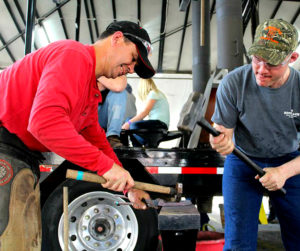BY DR. DAN CARTER
CJF, DVM

CJF, DVM
I recently treated an equine canker case, and it occurred to me that a lot of horse owners might not be able to recognize this painful infection that affects the hoof. It can show up in the frog, heel and underlying hoof structures. We haven’t completely isolated the organism that causes canker, but we do know warm and muddy conditions contribute to its prevalence – just the kind of conditions common in the Southeast. Lucky us.
Here’s the basic distinguishing factor for canker: it causes overgrowths. Early-stage canker has a doppelganger in thrush but this affliction actually destroys hoof tissue. Canker-infected horses may try to keep weight off the entire affected hoof or at least the heel. Worst case scenario: you’re looking at internal damage to the hoof structures on top of the external damage that’s visible.

SIGNS OF THRUSH
Smell – foul, rotten odor
Discharge – black moisture where frog meets sole
Sensitivity – pain in the frog when pressure is applied
Lameness – look for this in serious cases.
THRUSH PREVENTION
Clean – pick your horse’s hooves regularly, but take care not to damage the sulcus or frog so as not to create a point for bacterial entry.
Exercise – adequate turnout time can suffice here, but make sure your horse moves in order to keep circulation going in the hoof. Adequate blood supply is key to healthy hooves.
Regular farrier care – Hire an experienced farrier for trims – regular hoof care is the key to balanced, supportive hooves.
Environmental conditions – If at all possible, keep your horses on clean, dry ground. Wet, dirty bedding and manure mixed with mud make for the perfect stage for thrush.
The good news: canker is far less common than thrush. The bad news: it’s much harder to treat – it involves resecting the infected portions of the hoof. An antiseptic cleaning regimen is the essential follow up, and sometimes antibiotics are even necessary.
So which equines are most susceptible to canker? Well, the easy answer is all of them: it can affect all age groups, from foals to older horses.
Sometimes canker isn’t caught until it’s really taken hold in the hoof. At this point, you’re looking for cauliflower-like growths mounded at the back portion of the frog with (there’s just not a pleasant way to put this) puss-like excretions. If you find said conditions when picking your horse’s hooves, you’re probably apt to scream, drop the foot and hotfoot it to the phone to call your vet. Good move.
Here’s how the treatment is probably going to go. The tissue of the frog will easily loosen and bleed when your vet starts to poke around on the hoof. Also, pay attention to the smell: infected tissue will emit a foul odor when resected.
“OK so, what’s thrush?” you’re probably thinking at this point. Here’s what you need to know: it’s common and easy to spot – and smell. You’re looking for black bacteria with a tar-like consistency. Thrush is usually very treatable early on. However, as it invades the sole and vital structures, it can cause significant pain.
So with both thrush and canker, you need to be aware of the odor coming from your horse’s hoof – if it’s foul, call your vet.
Dr. Dan Carter is one of only five veterinarians in the U.S. who is also an AFA certified journeyman farrier. Dr. Carter owns and operates Countryside Veterinarian Services in Monticello and Covington, Ga. The Countryside offices are equipped to handle an array of procedures and surgeries beyond basic care for equines and small animals. See www.countrysidevets.com.


